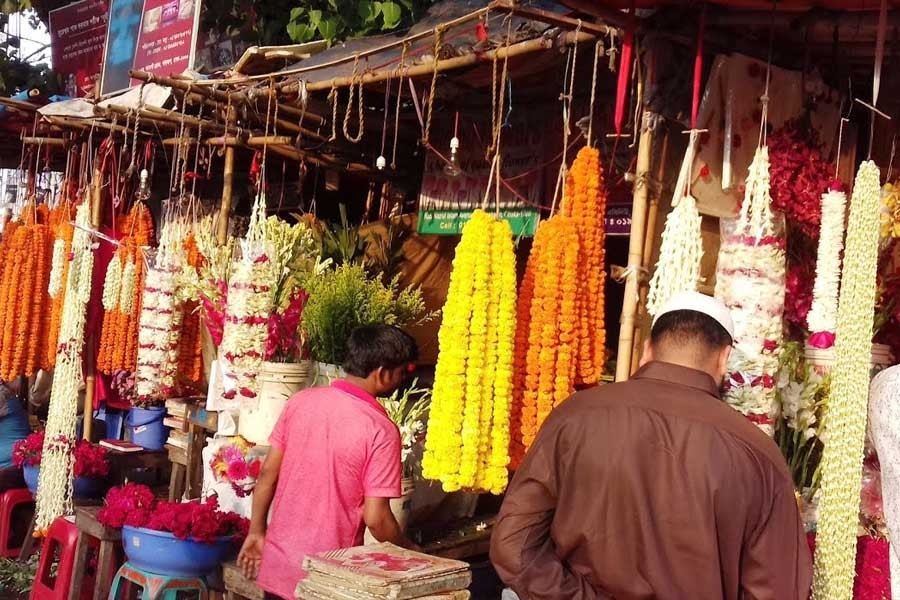
Published :
Updated :

What a time it is! The first day of Falgun is celebrated as Basontotsab (celebration of the Spring). Then the following day it is the Valentine's Day. For once the East meets, it seems in defiance of Kipling, the West with flowers taking the centre stage of the celebrations. Next, follows Ekushey Februray, the Language Martyred Day and the International Mother Language Day. On this day too paying homage to the language martyred is unthinkable without flowers.
The poet who declared that today is the Spring, no matter whether flowers bloom or not would have been immensely impressed by the Bangalees' love for flowers in this part of the world. Floriculture was foreign to this land before the 90's. The Hindu community used to grow flowers -albeit on a limited scale -on the precincts of their homestead simply because these are essential for offering puja or worship.
Now flowers have scaled the community divide in popularity on the strength of its transcendental value. Without flowers birthday and marriage day celebrations are unthinkable. In cities and towns the special car meant for carrying a bridegroom and his bride is profusely adorned with flowers. The stages where the two keep sitting or their marriage is solemnised are also lavishly decorated with flowers. From private celebration to the celebration of all the important national days, there is the use of flowers in the shape of bouquet, garlands or decoration pieces. The corporate houses also arrange many functions where flowers occupy an important place in the arrangement of the show. Cultural functions have always taken the lead in promoting floral beauty for enhancement of a gala event. Political and state functions now refuse to lag behind in the use of flowers.
Wide use of flowers in social and cultural events has thus placed a huge demand on the supply of flowers. The origin of commercial floriculture may have a small beginning in the early 90's, but its annual market has now become Tk 1.2 billion-strong. With 10 per cent annual growth, the flower market may hit Tk 1.5 billion mark this year.
The demand for flowers certainly reaches its peak in the month of Falgun (February) beginning with the first day (Pahela Falgun). Essentially it is a celebration of colours, of renewal of Nature or its regeneration after the atrocious Winter. The Winter may not be as numbingly chilly as it was before but still its debilitating influences tell on the natural world leaving the flora and fauna somewhat passive and lifeless. But with the advent of Falgun, Nature starts resuscitating with fresh vigour.
The Valentine's Day is a Western celebration that commemorates love or a bond between souls. What is noticeable is that the young generations have embraced this celebration as their own. They are unwilling to keep it at bay on the pretext that it is an alien culture. There is no harm in it as long as they take the inherent message of soulful nourishment to their hearts.
What is however less noticeable is that behind the popularity of such celebrations, what proves decidedly responsible is a stronger economy. People -a large segment of them to be precise -- in this country today have enough money to spare for flowers. For them it is not in the poet's urging, 'Jote jadi mote ekti poisa, khadya kinio khudar lagi; jote jadi duti poisa, ful kinio hey anuragi'( if you can manage just a penny, purchase food to appease hunger; when two pennies are at your disposal, spare one for flower). A country where the superrich (with wealth at least $ 30 million) are growing at a faster rate than anywhere in the world, the range of customers is large enough for any consumer good. Flowers, often a symbol of love, are no exception. Its heavenly quality too has been judged in terms of merchandise value.
No wonder that 2,500 families in 23 districts in the country have taken floriculture as their main occupation and about 200,000 people directly or indirectly depend on this agro enterprise. Intriguingly, the growth of this sector has not been dependent on any concerted promotional programme. Actually, it has followed the rules of the game of crop diversification. Like some exotic vegetables, cultivation of flowers proved more rewarding than paddy. But flowers are a sensitive commodity and unless advanced technology is adopted for their seeding, cultivation, cut foliage, transportation and marketing, the potential of the market cannot be fully realised. The global flower market is worth about $45 billion and Bangladesh earned nearly $80,000 last year.
Like growers of crops and vegetables, floriculturists gain less than florists and the middlemen in between. The supply chain is under control of commercial cliques. They are adept in manipulating market and ensure hefty benefit for themselves. It is no easy task to meet the heightened demand for flowers on three most important occasions within a few days of each other in a month. Flower growers get an opportunity for bargaining at this time every year. If they are smart enough, they too can dictate the term at this time. Without their labour and care, the Spring Festival, the Valentine's Day and the Ekushey February are unlikely to be half as colourful, celebratory and commemorative. So let those toiling hands behind the luxuriant bounties of Nature derive the benefits they deserve. They must as well be financially strong and happy at heart.


 For all latest news, follow The Financial Express Google News channel.
For all latest news, follow The Financial Express Google News channel.